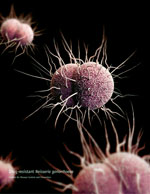Volume 22, Number 6—June 2016
Etymologia
Etymologia: Neisseria
A gram-negative, non-motile diplococcal bacterium, Neisseria (Figure) is named after Albert Ludwig Sigesmund Neisser, a German physician who discovered Neisseria gonorrhoeae in 1879.
Gonorrhea comes from the Greek gonos, meaning “seed,” and rhoe, “flow. The disease caused by this bacterium was known as “gonorrhea” because early physicians incorrectly thought the purulent discharge was semen. As early as 1719, gonorrhea was referred to as “the clap,” although theories for why it was called this vary. It may refer to the old French term clapier, “brothel,” a place where the disease spread easily. Another theory refers to preantibiotic days when the infection was treated by slapping the penis against a board, or clapping it between two boards to force out infected discharge.
N. gonorrhoeae is 1 of only 2 Neisseria species that is pathogenic to humans. The second, N. meningitidis, causes outbreaks of meningitis and septicemia. It was isolated by Anton Weichselbaum in 1887 and designated as Diplococcus intracellularis meningitidis.
References
- Boskey E. Gonorrhea: what is it, and why is it called the clap? About Health [cited 2016 Apr 11]. http://std.about.com/od/bacterialstds/a/gonoverview.htm
- Harper D. Gonorrhea. Online etymology dictionary [cited 2016 Apr 8]. http://medical-dictionary.thefreedictionary.com/Neisseria+gonorrhoeae
- Mosby’s Medical Dictionary. 8th ed. Neisseria gonorrhoeae [cited 2016 Apr 8]. http://medical-dictionary.thefreedictionary.com/Neisseria+gonorrhoeae
- Stephens DS. Biology and pathogenesis of the evolutionarily successful, obligate human bacterium Neisseria meningitidis. Vaccine. 2009;Suppl2:B71–7 . DOIPubMedGoogle Scholar
Figure
Cite This ArticleRelated Links
Table of Contents – Volume 22, Number 6—June 2016
| EID Search Options |
|---|
|
|
|
|
|
|
